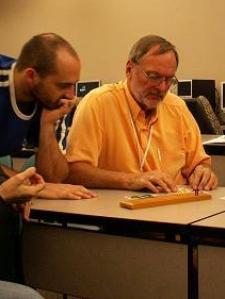Michael J. answered • 09/23/16
Tutor
5
(5)
Effective High School STEM Tutor & CUNY Math Peer Leader
Let x=Ø for all questions.
Q1)
Get the equation in terms of either sine of cosine.
7sin2x + 3(1 - sin2x) = 4
7sin2x - 3sin2x + 3 = 4
4sin2x - 1 = 0
4sin2x = 1
sin2x = 1/4
sinx = ±1/2
Since the angle is the first quadrant.
sinx = 1/2
Then we find cosine using the substitution.
cosx = √(1 - (1/2)2)
cosx = √(1 - (1/4))
cosx = √(3/16)
cosx = √(3) / 4
Then secx + cscx = (1 / cosx) + (1 / sinx)
Plug in the obtained values of cosx and sinx into this expression.
Q2)
x2 - y2 = (x - y)(x + y)
= [(asecx + btanx) - (atanx + bsecx)] * [(asecx + btanx) + (atanx + bsecx)]
Combine like terms and factor where possible.
= [secx(a - b) - tanx(a - b)] * [secx(a + b) + tanx(a + b)]
Next, look for the common factor in each piece.
= [(a - b)(secx - tanx)] * [(a + b)(secx + tanx)]
= (a - b)(a + b)(sec2x - tan2x)
Using the identity, we get
= (a - b)(a + b)[(1 / cos2x) - (sin2x / cos2x)]
= (a - b)(a + b)[cos2x / cos2x)]
= (a - b)(a + b)
= a2 - b2
Now try the last one on your own using the identity for cotangent. It is similar to Q2.






Kenneth S.
cosx = √(1 - (1/4))
cosx = √(3/16) ⇐ Here's an error!
cosx = √(3) / 4 ⇐ When sine is one half, in first quadrant, then cosine = ½•sq. root of 3, as is well known.
09/23/16